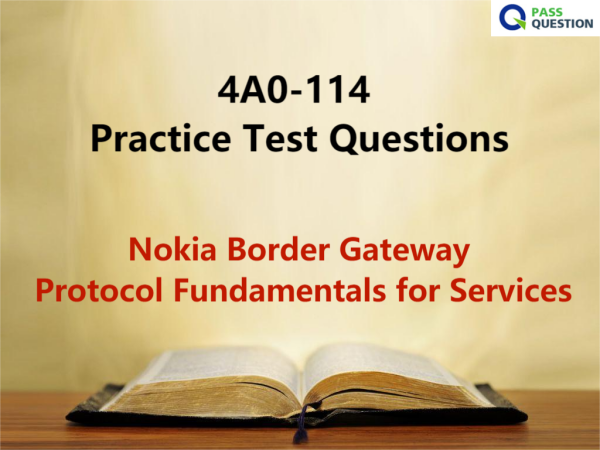4A0-114 Practice Test Questions - Nokia Border Gateway Protocol Fundamentals for Services
Looking for the simple and easiest way to pass the 4A0-114 Nokia Border Gateway Protocol Fundamentals for Services exam? PassQuestion provides the latest 4A0-114 Practice Test Questions which will not ace your exam preparation but also enable you to pass this challenging Nuage Network Routing Specialist II 4A0-114 exam with flying colors. 4A0-114 Practice Test Questions will give you a clear idea of how you can take a real Nokia 4A0-114 exam. It will help you assess your current preparation level so you can improve your preparation for the final Nokia 4A0-114 exam.

Exam Details
Exam name: Nokia Border Gateway Protocol Fundamentals for Services
Exam number: 4A0-114
Mandatory prerequisites: none
Exam duration: 75 Minutes
Exam appointment duration: 120 minutes. This is the exam duration plus a 45-minute tutorial on computer-based examinations.
Number of questions: 30
Language: English
Price: $125 US
Exam Modules
Module 1 – Border Gateway Protocol Fundamentals
- BGP overview
- BGP peering sessions
- BGP route updates and path attributes
- Basic route policies
Module 2 – Multi-protocol BGP
- When BGP becomes multi-protocol BGP
- IPv6 networks
- Layer-3 virtual private networks: the need for VPN-IPv4 and VPN-IPv6 addresses
- Inter-region transport tunnels: the need for label-IPv4 and label-IPv6 addresses
- VXLAN tunnels
- EVPN services: the need for the EVPN address family
Module 3 – BGP route reflectors
- Improving iBGP scalability using route reflectors
- Topology and operation of a route reflection cluster
- Avoiding route reflection loops
- Route reflector redundancy
- Route reflector configuration
View Online Nokia Border Gateway Protocol Fundamentals for Services 4A0-114 Free Questions
1. Which of the following is considered a best practice for BGP address planning?
A.Advertising external networks into IGP.
B.Using system addresses for setting up iBGP sessions.
C.Exporting the networks associated with the external links of eBGP peers into BGP.
D.Optimizing BGP route table by exporting IGP routes into BGP.
Answer: B
2. Which of the following statements regarding BGP shortcuts is FALSE?
A.MPLS tunnels are used to carry transit traffic across the network.
B.A full mesh of iBGP peering sessions is not required,
C.Edge and transit routers need to be configured with BGP.
D.The transit routers need to support LDP or RSVP-TE LSPs.
Answer: C
3. An autonomous system has 7 routers configured with BGP. How many iBGP sessions are required for a fully meshed configuration?
A.7
B.13
C.21
D.42
Answer: C
4. A BGP session is stuck in the "Connect" state. Which of the following is the most likely reason?
A.The remote BGP peer is properly configured but the local router is not.
B.The local router is properly configured but the remote BGP peer is not.
C.The BGP protocol is administratively disabled on the local router.
D.The BGP protocol is administratively disabled on the remote BGP peer.
Answer: B
5. Which of the following regarding route reflectors is TRUE?
A.Only the route reflector is configured with a cluster id.
B.There can only be one route reflector in a cluster.
C.Clients should have iBGP sessions with each other to maintain the mesh.
D.There can only be one level of route reflectors in the topology.
Answer: A
6. Which of the following statements about BGP is FALSE?
A.BGP uses Hello messages to dynamically discover BGP peers.
B.To establish a BGP session, a TCP session must first be established between the two routers.
C.BGP uses the OPEN message to exchange capability parameters between routers.
D.BGP was originally designed as an exterior routing protocol.
Answer: D
- TOP 50 Exam Questions
-
Exam
All copyrights reserved 2025 PassQuestion NETWORK CO.,LIMITED. All Rights Reserved.

